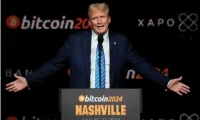As Donald Trump’s inauguration approaches on January 20, the spotlight is fixed on the cryptocurrency market. Bitcoin, the leading digital currency, reached an unprecedented milestone of $100,000 (£81,917) in December 2024, igniting anticipation within the crypto community. With Trump’s pledge to establish the United States as the “crypto capital of the planet,” analysts predict Bitcoin’s 2025 price could range from $78,000 to a staggering $250,000.
While blockchain technology boasts wide-ranging applications, such as enhancing supply chain efficiency, public attention remains captivated by the dramatic price surges of cryptocurrencies like Bitcoin, Ethereum, and so-called “meme coins.” These price movements are driven by speculative demand and the allure of outsized returns, rarely matched in traditional financial markets.
Investor behavior often reflects a pursuit of short-term gains rather than a commitment to the underlying technology’s long-term value. Meme coins, fueled by social media culture and enthusiasm, exemplify this trend, with minimal attention paid to their utility or sustainability.
The Trump administration’s anticipated crypto-friendly regulatory stance has attracted significant institutional interest. Industry giants, including BlackRock, are entering the crypto derivatives market, amplifying liquidity and drawing in a broader investor base. However, concerns linger over whether political endorsements might inflate a financial bubble akin to the late-1990s dotcom crisis.
Financial bubbles occur when asset prices diverge significantly from their intrinsic value. When these bubbles burst, they can destabilize related industries, even those without direct ties to the troubled assets.
Research has revealed that some companies have rebranded themselves with crypto-themed names to artificially boost stock prices, often without adopting blockchain technology. This superficial association makes such firms vulnerable to broader crypto market downturns.
Institutional involvement has deepened the interconnectedness between the crypto sector and traditional finance. Events like the Terra Luna and FTX collapses in 2022, and the bankruptcy of Silicon Valley Bank (SVB) in 2023, underscore the growing risks. When SVB collapsed, it destabilized Circle, the issuer of stablecoin USDC, which temporarily lost its dollar peg due to its $3.3 billion reserve exposure to the bank.
Even stable crypto assets like USDC and Tether are not immune to depegging risks, while meme coins, heavily influenced by social media hype, are particularly susceptible to speculative bubbles. Influential figures such as Elon Musk and Logan Paul have faced scrutiny for promoting meme coins, with allegations of undisclosed financial interests.
The U.S. Securities and Exchange Commission (SEC) has investigated such celebrity endorsements, though Trump’s proposed SEC chair, Paul Atkins, is a known crypto enthusiast. Critics warn that regulatory leniency could embolden market manipulation and insider trading, leaving investors vulnerable.
Despite its promise of financial freedom, cryptocurrency remains deeply influenced by social media-driven speculation. The 2022 market crash left many amateur investors facing significant losses, with some losing their life savings.
Easing crypto regulations may propel mainstream adoption but could undermine transparency and accountability, raising questions about the long-term implications for financial stability. As 2025 unfolds, the crypto market’s path to mainstream acceptance may come at a high cost for those unprepared for its inherent risks.
As Donald Trump pushes for the mainstream adoption of cryptocurrency, concerns grow over investor safety and financial stability amid speculation-driven markets and regulatory challenges.

